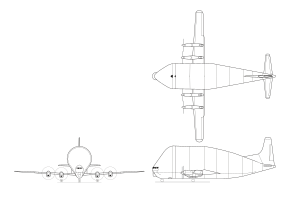The Aero Spacelines Super Guppy is a large, wide-bodied cargo aircraft that is used for hauling outsize cargo components. It was the successor to the Pregnant Guppy, the first of the Guppy aircraft produced by Aero Spacelines, which in turn was named for its resemblance to a pregnant guppy. Five were built in two variants, both of which were colloquially referred to as the "Super Guppy".
Design and development[]
The first, the Super Guppy, or "SG", was built directly from the fuselage of a C-97J Turbo Stratocruiser, the military version of the 1950s Boeing 377 "Stratocruiser" passenger plane. The fuselage was lengthened to 141 feet (Template:Convert/round m), and ballooned out to a maximum inside diameter of 25 ft (Template:Convert/pround m), the length of the cargo compartment being Template:Convert/LoffAonDbSoff2. The floor of the cargo compartment was still only Template:Convert/LoffAonDbSoff2 wide, as necessitated by the use of the Stratocruiser fuselage.[1]
In addition to the fuselage modifications, the Super Guppy used Pratt & Whitney T-34-P-7 turboprop engines for increased power and range, and modified wing and tail surfaces. It could carry a load of 54,000 pounds (Template:Convert/pround kg) and cruise at 300 mph (Template:Convert/pround km/h).

Super Guppy Turbine F-BPPA at Paris–Le Bourget Airport in 1981
The second version was officially known as the Super Guppy Turbine (SGT), although it used turboprop engines like the first Super Guppy. This variant used Allison 501-D22C turboprops. Unlike the previous Guppy, the main portion of its fuselage was constructed from scratch. By building from scratch, Aero Spacelines was able to widen the floor of the cargo compartment to 13 ft (Template:Convert/round m). The overall cargo compartment length was increased to Template:Convert/LoffAonDbSoff2, and the improved fuselage and engines allowed for a maximum load of 52,500 lb (Template:Convert/round kg).[2] These design improvements, combined with a pressurized crew cabin that allowed for higher-altitude cruising, allowed the SGT to transport more cargo than its predecessors.[1]

Super Guppy Turbine being unloaded
The SGT retained only the cockpit, wings, tail, and main landing gear of the 377. The nose gear was taken from a Boeing 707 and rotated 180 degrees. This dropped the front of the aircraft slightly, leveling the cargo bay floor and simplifying loading operations.
In the early 1970s, the two Super Guppies were used by Airbus to transport aeroplane parts from decentralised production facilities to the final assembly plant in Toulouse. In 1982 and 1983, two additional Super Guppies were built by Union de Transports Aériens Industries in France after Airbus bought the right to produce the aircraft. The four Super Guppies have since been replaced by the Airbus Beluga, capable of carrying twice as much cargo by weight.
Variants[]
- Aero Spacelines B-377-SG Super Guppy, prototype of a much enlarged version of the Guppy using C-97J components, powered by four Pratt & Whitney T-34-P-7WA turbo-prop engines.[1]
- Aero Spacelines B-377-SGT Super Guppy Turbine (Guppy 201), production version powered by Allison 501-D22C turbo-prop engines,[1] using an enlarged cargo section built from scratch instead of being converted from original C-97J components.
Survivors[]

NASA Super Guppy on display at Pima Air & Space Museum
All Super Guppies remain either in service, mothballed, or on display.
- Super Guppy N940NS (previously N1038V), serial number 52-2693, is on preserved display at the Pima Air & Space Museum adjacent to Davis–Monthan Air Force Base in Tucson, Arizona.[3]
- Super Guppy Turbine F-BTGV (formerly N211AS), serial number 0001, is on static display at the British Aviation Heritage Centre, Bruntingthorpe Aerodrome, United Kingdom.
- Super Guppy Turbine F-BPPA (formerly N212AS), serial number 0002, is on static display in the Musée Aeronautique Aeroscopia near the Airbus facility, Toulouse–Blagnac, France.
- Super Guppy Turbine F-GDSG, serial number 0003, is on static display at the Airbus facility, Hamburg Finkenwerder Airport, Germany.
- Super Guppy Turbine N941NA (formerly F-GEAI), serial number 0004, is in service with NASA as a transport aircraft and is based at the El Paso Forward Operating Location at the El Paso International Airport, in El Paso, Texas.[4]
Operators[]
- Aero Spacelines
- Aeromaritime
- Airbus
- NASA
Specifications (Super Guppy Turbine)[]

Orthographic diagram of the 377-SGT
Template:Aircraft specifications
See also[]

Super Guppy Turbine F-GDSG at Paris–Le Bourget Airport in 1984
Template:Aircontent
References[]
- ↑ 1.0 1.1 1.2 1.3 Cite error: Invalid
<ref>tag; no text was provided for refs namedJanes - ↑ Cite error: Invalid
<ref>tag; no text was provided for refs namedsfnasa-jscsg - ↑ "Super Guppy". Pima Air & Space Museum. http://www.pimaair.org/visit/aircraft-by-name/item/super-guppy. Retrieved 19 May 2014.
- ↑ Cite error: Invalid
<ref>tag; no text was provided for refs namedelpaso20110804
External links[]
Template:Commons category multi
- NASA Super Guppy website
- Johnson Space Center's Super Guppy website
- Boeing B-377 history website
- "All About Guppys" - Historical information website about the Guppy aircraft
- Super Guppy Restoration Project - Website for the F-BTGV restoration project
Template:B-29 family
| This page uses Creative Commons Licensed content from Wikipedia (view authors). | 
|